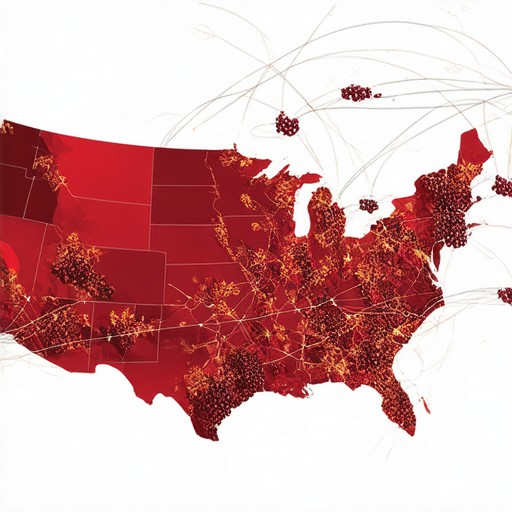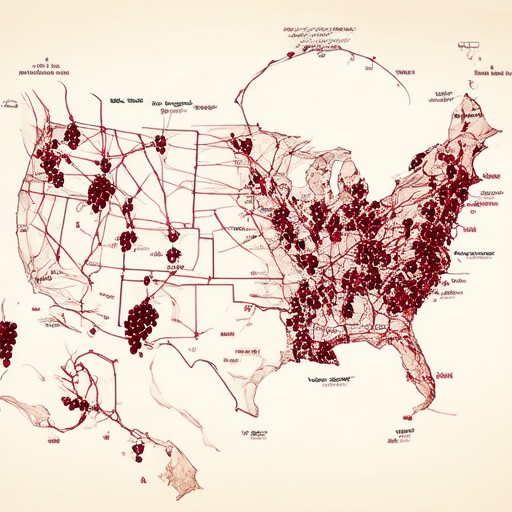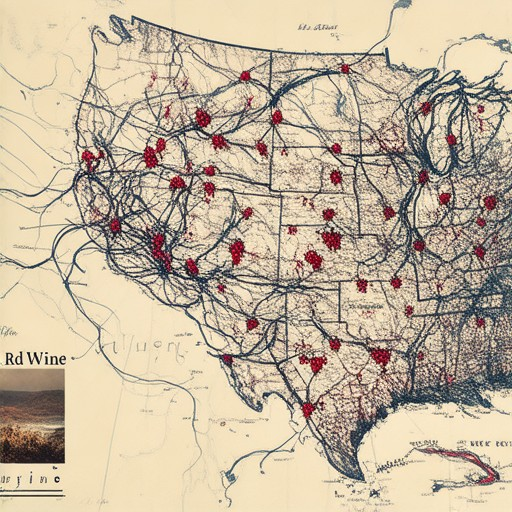Exploring the world of red wine can be an exhilarating journey, where each region offers unique flavors, textures, and stories. For those who savor the rich, bold hues of red wine, understanding which regions produce the finest vintages is essential. From the sun-kissed vineyards of California to the fertile soils of the Pacific Northwest, the United States boasts a diverse array of wine regions that cater to every palate. Whether you’re a seasoned wine enthusiast or new to the world of red wines, discovering the top grape varieties and the ideal settings for these wines can elevate your drinking experience to new heights. This guide delves into the key regions, grape varieties, and considerations that make American red wines truly exceptional.
Key Takeaways
– Top Red Wine Regions in the USA: Discover the best U.S. wine regions for red wine, including Napa Valley, Sonoma, Santa Barbara, and Washington State, known for their premium grape varieties and award-winning vintages.
– Key Red Wine Grapes: Explore five top red wine grapes—Cabernet Sauvignon, Merlot, Pinot Noir, Syrah (Shiraz), and Zinfandel—that dominate the market and offer versatile flavor profiles.
– Essential Wine Knowledge: From grape varieties to winemaking techniques, understand the “5s of Wine”—varietals, regions, grapes, winemaking, and food pairing—to enhance your wine appreciation and selection skills.
– Wine Region Highlights: Learn about global wine regions like Italy, France, Spain, and China, which contribute to the diversity and quality of red wines worldwide.
– Winning Pairings: Elevate your dining experience with expert tips on pairing red wines with hearty dishes, cheeses, and more.
Explore more insights and guides to elevate your wine knowledge at Fine Vines.

What Region is Best for Red Wine?
The best region for red wine production is often debated, but several stand out for their quality and consistency. Here’s a breakdown of top-producing regions and their notable contributions:
- France : Renowned for its diverse regions like Bordeaux, Burgundy, and the Rhône Valley, France is celebrated for its high-quality red wines. Key varieties include Cabernet Sauvignon, Merlot, Pinot Noir, and Syrah. The combination of rich terroir, climate, and winemaking expertise makes French reds highly regarded worldwide.
- Italy : Known for its bold and aromatic reds, Italy produces iconic wines like Chianti (Tuscany) and Barolo (Piedmont). The region’s diversity in soil and climate allows for a wide range of styles, from elegant to robust.
- Spain : Spain’s Rioja region is famous for its rich, age-worthy reds made from Tempranillo grapes. Other notable areas include Ribera del Duero and La Mancha, contributing to Spain’s growing reputation for high-quality wines.
- Australia : With a focus on Shiraz and Cabernet Sauvignon, Australia’s Hunter Valley and Coonawarra regions are known for their full-bodied and fruit-forward reds. The country has also gained recognition for premium sparkling wines from regions like Yarra Valley.
- California : Napa Valley is synonymous with world-class reds, particularly those made from Cabernet Sauvignon, Merlot, and Zinfandel. Wineries like Opus One and Mondavi have set benchmarks for quality and innovation.
- Argentina : The country’s signature grape, Malbec, thrives in Mendoza, producing intense, dark-red wines with notes of berries and spice. Argentina is also gaining attention for its elegant Torrontés whites.
- Chile : Known for its cool climates and long growing seasons, Chile excels in producing concentrated and ageworthy reds, particularly from the Maipo Valley and Colchagua regions.
- Portugal : The Douro Valley is famous for its Port wines, a fortified red typically blended from Touriga Nacional and Tinta Negra grapes. Unfortified reds from regions like Alentejo and Ribatejo are also gaining international acclaim.
- Germany : While less well-known globally, Germany produces excellent reds, particularly from the Mosel and Saar regions. These wines often feature delicate aromas and fine tannins, complementing dishes like roasted meats and game.
- Austria : Known for its precision and elegance, Austrian reds, particularly from the Wachau Valley, showcase varieties like Zweigelt and Blaufränkisch. These wines offer complexity and balance that appeal to discerning palates.
While France often tops lists due to its historical dominance and diversity, Italy and Spain are strong contenders with their unique profiles. The choice ultimately depends on personal preference, as each region offers distinct characteristics and wine profiles.
For more insights into wine regions and their specialties, explore our wine region guides .
What Should Red Wine Be Set At?
The optimal serving temperature for red wine is generally between 55-65 degrees Fahrenheit. This range ensures that the wine’s body and flavors develop optimally, allowing its aromas and tastes to express themselves fully.
Serving red wine slightly cooler than room temperature helps prevent the alcohol from becoming overpowering, which can sometimes mask the wine’s nuances. On the other hand, serving it too cold can make it feel harsh or “hot” when swallowed.
For those without a wine cooler, you can quickly chill red wine by placing it in the refrigerator for about 30 minutes before serving. If the wine is slightly warmer than ideal, it can still be enjoyable, especially if it’s at room temperature or slightly above.
Additionally, the ideal serving temperature may vary depending on the wine’s origin or grape variety. For instance, some regions might prefer a slightly different range based on their wine styles. However, sticking to the general guideline of 55-65°F is a safe bet for most red wines.
For more detailed information on wine serving temperatures and wine education, visit our wine education guide or explore our about us page to learn more about our commitment to wine excellence.

Best Region for Dry Red Wine
Dry red wines are produced in several of the world’s most renowned wine-producing regions, each offering unique characteristics based on climate, soil, and grape variety. Here are some of the top regions:
- Bordeaux, France : Known for its consistency and quality, Bordeaux is particularly famous for its Cabernet Sauvignon-based wines. The left bank, specifically the Medoc and Graves regions, is renowned for producing some of the finest dry red wines in the world.
- Napa Valley, USA : Renowned for its optimal climate conditions, Napa Valley is home to some of the most highly rated Cabernet Sauvignon wines. Its combination of warm days and cool nights allows for the development of rich, complex flavors.
- Tuscany, Italy : While Tuscany is better known for its Super Tuscan wines, which are blends of international varieties like Cabernet Sauvignon and Merlot, the region offers a diverse range of high-quality dry red wines.
- Colchagua Valley, Chile : Located in the southern part of Chile, this valley is celebrated for its ability to produce intense, balanced Cabernet Sauvignon wines. The region’s unique combination of warm days and cool nights contributes to the wine’s structure and flavor profile.
- Stellenbosch, South Africa : Known for its unique terroir, Stellenbosch has emerged as a leading producer of premium dry red wines. The region’s diversity in soil types and climates allows for wines that combine fruitiness with structure.
- Coonawarra and Marlborough, Australia/New Zealand : These regions offer unique expressions of dry red wine, benefiting from their respective climates and viticultural practices. Coonawarra in Australia is particularly noted for its Cabernet Sauvignon, while Marlborough in New Zealand produces distinctive Syrah-based wines.
Each of these regions brings something unique to the table, making them among the best places to find exceptional dry red wines. Whether you prefer the classic elegance of Bordeaux or the bold intensity of Napa Valley, there’s a region that aligns with your taste preferences.

What Are the Five Regions of Wine?
The global wine production is dominated by several key regions, each known for its unique climates, soils, and winemaking traditions. These regions contribute significantly to the diversity and quality of wines available worldwide. Below is a breakdown of the five most prominent wine-producing regions:
1. **Italy**
- Italy is renowned for its vast array of wine regions, producing everything from lightweight, aromatic whites to rich, bold reds.
- Key regions include Chianti, Tuscany, Piedmont, Veneto, and Umbria.
- The Italian wine sector is characterized by a strong emphasis on quality and tradition, with many wines achieving DOC (Denominazione di Origine Controllata) status.
2. **France**
- France is often regarded as the world’s premier wine country, with a diverse range of appellations and grape varieties.
- Major wine regions include Bordeaux, Burgundy, Champagne, Rhône Valley, and Loire Valley.
- French wines are noted for their elegance, complexity, and ability to age gracefully.
3. **Spain**
- Spain boasts a wide variety of wine regions, each contributing distinct styles and profiles.
- Prominent regions include Rioja, La Rioja Alcásar, Ribera del Duero, and Penedès.
- Spanish wines are increasingly recognized for their balance, intensity, and ability to pair well with a variety of cuisines.
4. **United States**
- The United States is a leading producer of high-quality wines, with California dominating the market.
- Key wine regions include Napa Valley, Sonoma, Santa Barbara, and Washington State.
- American wines are known for their fruit-forward flavors, versatility, and innovation in winemaking techniques.
5. **China**
- China has emerged as a major player in the global wine market, particularly in the production of bulk wines.
- Regions such as Ningxia and Shandong are gaining recognition for their high-quality wines.
- Chinese wines are often characterized by their fruitiness and approachable profiles, suitable for everyday drinking.
These regions collectively account for a significant portion of the world’s wine production, contributing to the diversity and richness of the global wine landscape. Each region brings its unique terroir, grape varieties, and winemaking philosophies, resulting in a wide range of styles and prices.
- Explore our comprehensive wine tasting guides
- Discover insights into the world’s finest vineyards
- Master the art of wine pairing with our expert tips
What Are 5 Red Wine Grapes?
Here are five popular red wine grapes known for their versatility and quality:
- Cabernet Sauvignon – A classic variety originally from Bordeaux, France, Cabernet Sauvignon is widely planted worldwide. It produces bold, rich wines with flavors of blackcurrant and cedar.
- Merlot – Hailing from Bordeaux, Merlot is a soft, aromatic grape often used in blends. It contributes to medium-bodied wines with plum and chocolate notes.
- Pinot Noir – A Burgundy native, Pinot Noir is known for its elegance and complexity. It produces wines with earthy, berry, and spice characteristics.
- Syrah (Shiraz) – Originally from the Rhône Valley, Syrah is now grown in many regions. It creates intense, spicy wines with dark fruit flavors.
- Zinfandel – A California favorite, Zinfandel is known for its bold, jammy profile. It pairs well with hearty dishes and offers a sweet, peppery finish.
These grapes are essential to the production of a wide range of red wines, each bringing unique characteristics to the glass. Whether you prefer bold, elegant, or spicy profiles, these varieties offer something for every palate. For more details on wine grape varieties, visit Fine Vines .

What Are the 5s of Wine?
Here’s a breakdown of the essential aspects of wine, organized into five key categories:
- 1. Varietals: Wine is produced from various grape varieties, each with unique characteristics. Popular varietals include Chardonnay, Cabernet Sauvignon, Merlot, Pinot Noir, and Syrah.
- 2. Regions: Wine regions differ based on climate, soil, and grape variety. Notable regions include Bordeaux (France), Napa Valley (USA), Tuscany (Italy), and Sonoma (USA).
- 3. Grapes: Specific grape varieties are often used to name wines. Examples include Sauvignon Blanc, Zinfandel, and Riesling.
- 4. Winemaking: The process involves fermentation, aging, and bottling. Red wines are aged in oak barrels, while white wines may undergo different techniques depending on the region.
- 5. Food Pairing: Wines pair well with specific foods. Red wines often complement red meats and cheeses, while white wines pair nicely with seafood and light dishes.
This overview provides a foundation for understanding wine, from its production to its enjoyment. For more details, explore our wine guide .



0 Comments